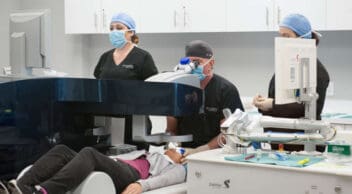
Medically Reviewed by Philina Yee, M.D. NVISION Surgeon
Glaucoma Laser Surgery: Is It Your Best Choice?
Home / Diagnosed With Glaucoma /
Last Updated:

Medically Reviewed by Philina Yee, M.D. NVISION Surgeon
Navigating through the choices for glaucoma treatment can be complex. While eye drops often serve as the initial course of action, after looking at the pros and cons of laser surgery for glaucoma you see that it is a viable alternative, particularly for cases resistant to medication. Laser surgeries like trabeculoplasty and iridotomy offer quick, outpatient relief for both open-angle and angle-closure glaucoma but come with their own set of risks.
Table of Contents
While it is not always necessary, laser treatment is a good option for treating certain cases. It is a simple outpatient procedure that can help to lower high fluid pressure in a matter of weeks.
There are two types of laser surgery. Laser trabeculoplasty helps open-angle glaucoma, and laser iridotomy alleviates pressure in angle-closure glaucoma, which is a medical emergency.
Although laser surgery is not the front-line treatment for open-angle glaucoma, some medical studies suggest that it should be. Like any surgery, it is not without risk.
If you are diagnosed with glaucoma, and you think a laser surgery might work better for you than eye drops, talk to your ophthalmologist.
When Is Laser Surgery for Glaucoma Appropriate?
There are three types of surgery that can help to drain fluid from your eyes if you have glaucoma.
- Laser surgeries that create new, small drainage holes
- Trabeculectomy, in which your surgeon uses a small knife to make incisions in the sclera to drain fluid
- Glaucoma drainage devices, which are implanted to move aqueous humor from inside your eye to a drainage area in your conjunctiva, where it is absorbed by blood vessels
You deserve clear vision. We can help.
With 135+ locations and over 2.5 million procedures performed, our board-certified eye surgeons deliver results you can trust.
Your journey to better vision starts here.
While severe glaucoma may require a trabeculectomy or an implanted drainage device, your ophthalmologist is most likely to start your treatment plan with eye drops. Some types of chronic glaucoma do not respond to eye drops, or your fluid pressure may be high enough that your ophthalmologist wants to approach the problem with a combination of laser eye surgery and eye drops.
There are two types of laser glaucoma surgery.
- Trabeculoplasty: For people who have open-angle glaucoma that is advancing faster than average, or that does not respond to eye drops, this type of laser surgery can lower fluid pressure. A guided laser will make small holes around your sclera to allow fluid to flow out.
- Iridotomy: This form of laser surgery is for people with acute, or angle-closure, glaucoma. A guided laser makes a tiny hole in the iris, which helps fluid drain out faster.

During either procedure, your eye surgeon will give you numbing eye drops so you feel little to no discomfort or pain during this quick operation. You will sit in front of the laser machine. You may see flashes of green or red during the procedure, which is the laser making tiny incisions.
If you have glaucoma in both eyes, your doctor can treat them both on the same appointment. They may also choose to operate on one eye and see how well you heal, and then schedule the next eye for a few days or weeks later.
Like other types of laser surgery, most people recover quickly with about a day of rest, and they can then return to work the next day. Unlike some other laser surgeries, you need to wait between four and six weeks to know if the procedure worked. A follow-up appointment to measure your eye pressure and examine the overall health of your eyes can help your ophthalmologist understand next steps.
Can Laser Surgery Be the First Line of Treatment for Glaucoma?

Iridotomy is the best first approach for most forms of acute glaucoma. Trabeculoplasty may be a good option for open-angle glaucoma, but that depends on what type of open-angle glaucoma you have. Your ophthalmologist is likely to prescribe eye drops to you first and see how your eyes respond to this treatment. If they do not respond, a laser procedure may be recommended to you.
Recent medical studies show that a combination of laser surgery and eye drops may be the best approach for several types of chronic glaucoma. The LiGHT Trial involved 718 participants with primary open-angle glaucoma and ocular hypertension. Half were randomly selected to receive glaucoma eye drops, while the other half underwent selective laser trabeculoplasty (SLT).
Three years after the study, 74 percent of people who received SLT did not require eye drops to keep their eye pressure at a safe level. Those who underwent SLT rather than managing with just eye drops were more likely to be within their target eye pressure range at their routine eye exams compared to people who continued to use eye drops. That said, both groups had good success managing eye pressure, with 90 percent reaching a target range for ocular fluid pressure after three years.
The LiGHT Trial suggests that a laser trabeculoplasty may be a good first step for newly diagnosed glaucoma rather than using it as a last resort. While many of the study participants managed to use eye drops as directed, finding a way to help glaucoma patients manage their symptoms without medication can improve quality of life and reduce side effects that are often associated with regular prescriptions.
Like any other surgery, laser glaucoma surgeries carry some risk of side effects. These include:
- Risk of a fluid pressure spike.
- Risk of fluid pressure being too low.
- Risk of blindness (very rare).
When Should I Get Laser Surgery?
Non-laser surgeries for glaucoma are more invasive, so they are not the preferred approach to managing the condition. If you receive a diagnosis of open-angle glaucoma, ask your ophthalmologist about laser surgery rather than eye drops or using a combination of these treatments to lower your fluid pressure.
You deserve clear vision. We can help.
With 135+ locations and over 2.5 million procedures performed, our board-certified eye surgeons deliver results you can trust.
Your journey to better vision starts here.
References
- At a Glance: Glaucoma. (July 2019). National Eye Institute (NEI).
- Glaucoma Treatment. (August 2019). American Academy of Ophthalmology (AAO).
- Laser Treatment for Glaucoma. (June 2019). National Eye Institute (NEI).
- Eye Drops vs. Laser Treatment for Glaucoma. (June 2019). BrightFocus Foundation.
- Treating With SLT First: The Pros and Cons. (June 2017). Review of Ophthalmology.

Dr. Yee is a glaucoma specialist trained in the medical and surgical management of glaucoma. She also provides comprehensive ophthalmological services for adolescents and adults.
This content is for informational purposes only. It may have been reviewed by a licensed physician, but is not intended to serve as a substitute for professional medical advice. Always consult your healthcare provider with any health concerns. For more, read our Privacy Policy and Editorial Policy.
